|
ACADIA NATURE NOTES
| Volume 5 |
Spring Number, 1939 |
Number 1 |
FLOWERS YELLOW
FALSE OAT
May-June
Oakesia sessilifolia - Lily family.
An inconspicuous May blossom of the rich moist evergreen woods.
| Root |
Slender, creeping. |
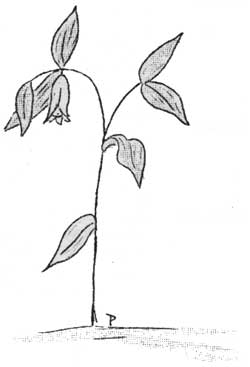 |
| Stem |
Leafy, 10"-12" high, curving above the middle and bearing
one or two nearly terminal flowers. |
| Leaves |
Alternate, oblong-pointed, rough-margined, parallel-veined.
Not clasping the stem as in Bellwort. l-1/2"-3" long. |
| Flowers |
Pale yellow, lily or oat-like, drooping and often
hidden by the leaves, 3/4" long, six parted. |
| Fruit |
Capsule containing rounded seeds. |
The common name, False Oat, indicates the resemblance of the flower to
the drooping oat. The scientific name is in honor of William Oakes, an
early New England botanist.
FLOWERS YELLOW
YELLOW ROCKET or WINTER CRESS
Early June.
Barbarea vulgaris - Mustard family.
A path of yellow in field, meadow, and waste places.
| Root |
Long, fibrous. |
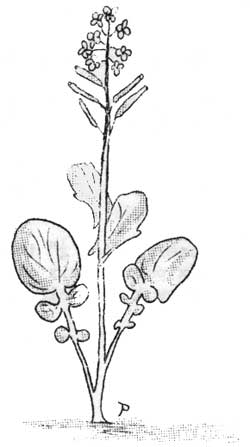 |
| Stem |
Erect, 1'-2' high, simple, smooth. |
| Leaves |
Lower leaves 2"-5" long, toothed, lobed, the terminal
divisions much larger than the lateral ones. Upper
leaves sometimes clasping. |
| Flower |
Bright yellow, four petals, six stamens, 1/3"-1/4" across. |
| Fruit |
Pods, spreading, 1" long. |
A similar appearing plant is Brassica nigra, page 37, a
widely-branched species, hairy, never with clasping upper
leaves.
This plant is one of the commonest spring weeds that bloom in fields,
waste places, and along roadsides. In ancient times it was known as the
herb of St. Barbara.
FLOWERS YELLOW
BLACK MUSTARD
Late May - Early June
Brassica nigra - Mustard family.
Another yellow weed of field, meadow and roadside.
| Root |
Fibrous. |
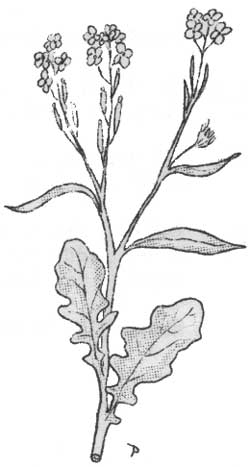 |
| Stem |
Freely and widely branching, hairy. |
| Leaves |
Lower 2"-5" long, toothed, deeply lobed, terminal
lobe large. Upper leaves lance-shaped and not clasping. |
| Flower |
Bright yellow, 1/4"-1/2" broad. |
| Fruit |
Pods, pressed against the stem, 1/2" - 3/4" long. |
This plant bears the scientific name of the Cabbage.
A very common field weed.
FLOWERS YELLOW
CLINTONIA
Early June-July
Clintonia borealis - Lily family.
Along the borders of woodland streams in the cool moist shade of the
evergreens grows the lily-like Clintonia.
| Root |
Slender and deep. |
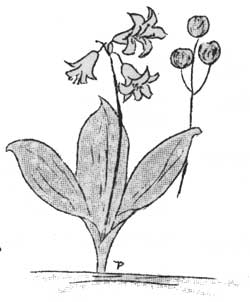 |
| Flower Stalk |
6"-16" high, bearing 2-6 flowers, sheathed
by basal leaves. |
| Leaves |
2-5 leaves, oblong pointed,
4"-7" long, dark glossy green. |
| Flower |
Yellow, slight green tinge, 3/4" long, nodding. Six petals, six
sepals, six stamens, ovary 2-celled. |
| Fruit |
Round blue berries on upright stems. |
Many plants bear the name of some well-known botanist or famous person.
Clintonia is in honor of DeWitt Clinton, once Governor of New York and
an ardent amateur botanist.
The blue berry of the Clintonia fruit is a rare case of pure blue
color in nature. The purplish tinge usually found in blue colors is
absent here.
SPRING AGAIN
"For lo, the winter is past, the rain is over and gone; the flowers
appear on the earth, the time of the singing of birds is come, and the
voice of the turtle is heard in our land."
—Solomon.
FLOWERS YELLOW
MOUNTAIN FLY HONEYSUCKLE
May - June
Lonicera caerulea var. villosa - Honeysuckle family.
Common on low ground and in bogs, also frequent on mountain slopes and
summits.
| Stem |
Erect, shrub-like. |
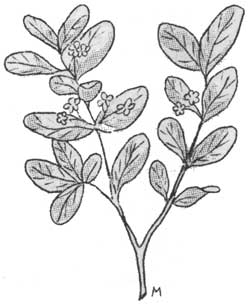 |
| Leaves |
Elliptical or oblong, rarely slightly oval, toothless,
light green above, paler beneath, conspicuously net-veined, 1"-2-1/2" long. |
| Flowers |
Pale honey yellow, five-lobed,
honeysuckle-like, about 2/3" long, in pairs at base of leaves. |
| Fruit |
Ovaries unite and form a single cadet blue or gray-black berry, 1/5" in
diameter, ovoid-spherical, with two eyes; edible. |
This plant is a relative of the common honeysuckle of cultivation which
is usually cross-fertilized by the larger long-tongued bees,
moths, and butterflies, as well as the humming bird.
FLOWERS YELLOW
INDIAN CUCUMBER-ROOT
June
Medeola virginiana - Lily family.
Found in the cool, moist, shaded woodlands.
| Root |
Fleshy, 1"-3" long. |
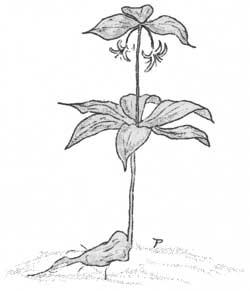 |
| Stem |
1'-2-1/2' tall, bearing a lower whorl of leaves above the
middle. |
| Leaves |
Of the lower whorl close to the stem, 2-1/2"-5" long,
1"-2" wide, pointed at the apex, narrowed at the base,
3-5 nerved and net-veined; leaves of the upper whorl 1"-2"
long, 1/2"-1" wide. |
| Flower |
Yellow umbrella-like cluster of 2-9 flowers, nodding,
appearing spidery. |
| Fruit |
Erect, dark purple berry. |
The crisp, juicy root tastes somewhat like cucumber and was relished by
the Indians, hence the common name.
FLOWERS YELLOW
YELLOW CINQUEFOIL or FIVE FINGERS
Early June
Potentilla canadensis - Rose family.
Abundant in dry fields, on hillsides and along roadways.
| Roots |
Long slender runners from a leafy tuft, 3" to 2' long. |
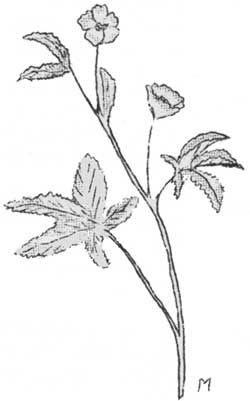 |
| Stem |
Long, smooth. |
| Leaves |
Five thin, coarsely-toothed, finely veined leaflets;
oblong in shape, narrowed toward base; lighter on
under side, 1/2" to 1" long. |
| Flowers |
Yellow, single flower; 5 broad, oval petals;
numerous stamens; petals notched at apex. |
The name "Potentilla" is derived from potens, refers to the
medicinal properties of some of this meaning powerful and group.
FLOWERS YELLOW
TALL BUTTERCUP
Early June.
Ranunculus acris - Crowfoot family.
One of the common buttercups of field and meadows.
| Root |
Fibrous. |
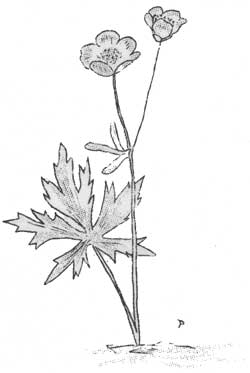 |
| Leaves |
Hairy, branched and less hairy above, deep green, 2'-3' high,
hollow and stout. |
| Leaves |
3-7 stemless divisions divided into linear segments,
cut and slashed, only upper ones showing simple 3 parted figure,
1"-4" long. |
| Flowers |
1" broad, 5 broad petals, overlapping, set on long stem,
bright yellow, inner surface glossy, outer, dull and paler. |
Naturalized from the old country.
Acrid juice, if stem carried in mouth, causes blisters to appear on
the lips and tongue. Hence, it is sometimes called Blister
Flower.
The scientific name is from the Latin, rana, meaning "a small
frog", applied by Pliny because ome of the Crowfoots grew where frogs
were plentiful.
FLOWERS YELLOW
BULBOUS BUTTERCUP
May - August
Ranunculus bulbosus - Buttercup family.
Open sunny fields and meadows are often dotted with the yellow cup of
this plant.
| Root |
Bulbous, thickened at base. |
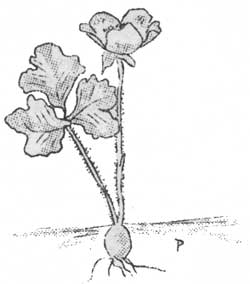 |
| Stem |
Erect, hairy. |
| Leaves |
Deep green, three divided, decoratively cut, wedge shaped, 1-1/2"
long, 1"-2" wide. |
| Flower |
Yellow, 1" across, green sepals bent downward,
petals roundish. |
Over fifty species of insects visit the common buttercups.
The buttercups abound undisturbed in pastures and fields, for a very
interesting reason. Certain relatives of Aconite and Larkspur have
poisonous qualities, and the kinship is evident in the acrid, caustic
juice of the buttercup. Because of this juice horses and cattle
intentionally avoid the buttercups and leave them free to abound in any
pasture land.
When dried as hay, the buttercup loses its acrid juice and makes good fodder.
FLOWERS YELLOW
COMMON DANDELION
Late May - September
Taraxacum officinale - Composite family.
Found in fields and waste places.
| Root |
Thick, deep, 10" long, bitter. |
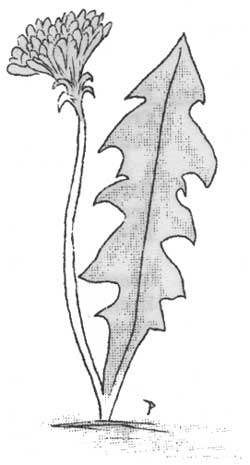 |
| Flower Stalk |
Erect, hollow, milky. |
| Leaves |
Oblong to spatulate, acute, coarsely toothed,
3"-10" long, 1/2"-2-1/2" wide. |
| Flowers |
A head, golden yellow, solitary, 1"-2" across,
containing 100-150 tiny florets; sepals united into a tube, petals
strap-shaped, stamens, 5. |
| Fruit |
Seeds ribbed, rough, soft, silky, hair-like projections at apex of
each seed. |
The dandelion blooms early and late in all kinds of soil.
The name Dandelion is said to be a corruption of the French
"dent-de-lion", meaning lion's tooth and referring
to the leaf outline which is said to resemble that of the lion's
tooth.
"Dear common flower that grow'st beside the way
Fringing the dusty road with harmless gold."
—Lowell.
FLOWERS YELLOW
WOOD BETONY or LOUSEWORT
Late May - June
Pedicularis canadensis - Figwort family.
Usually found in meadows and along stream banks, occasionally in very
open moist woods.
| Root |
Tough, fibrous. |
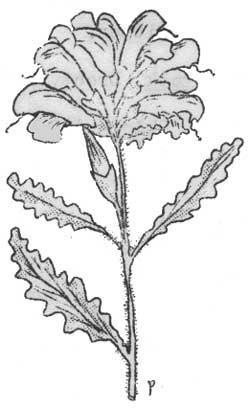 |
| Flowering Stalks |
Several springing from the center of a leaf cluster, 6"-18" high. |
| Leaves |
Soft, hairy, dull dark green and finely lobed, 3"-5" long and
fern-like. |
| Flowers |
Greenish yellow and crimson. Each complete flower resembles the head of
the walrus, even to the tusks. |
| Fruit |
A sword-shaped, flat capsule. |
Looking straight down on the blossom one immediately notices the rip-saw
symmetry. The name Pedicularis means louse and was applied by
farmers who thought that when sheep ate the plant they developed lice.
The plant belongs to a family of nearly 2,700 species, most of them
yielding narcotic poisons.
|

